Boyle J.A. The Cambridge History of Iran, Volume 5: The Saljuq and Mongol Periods
Подождите немного. Документ загружается.

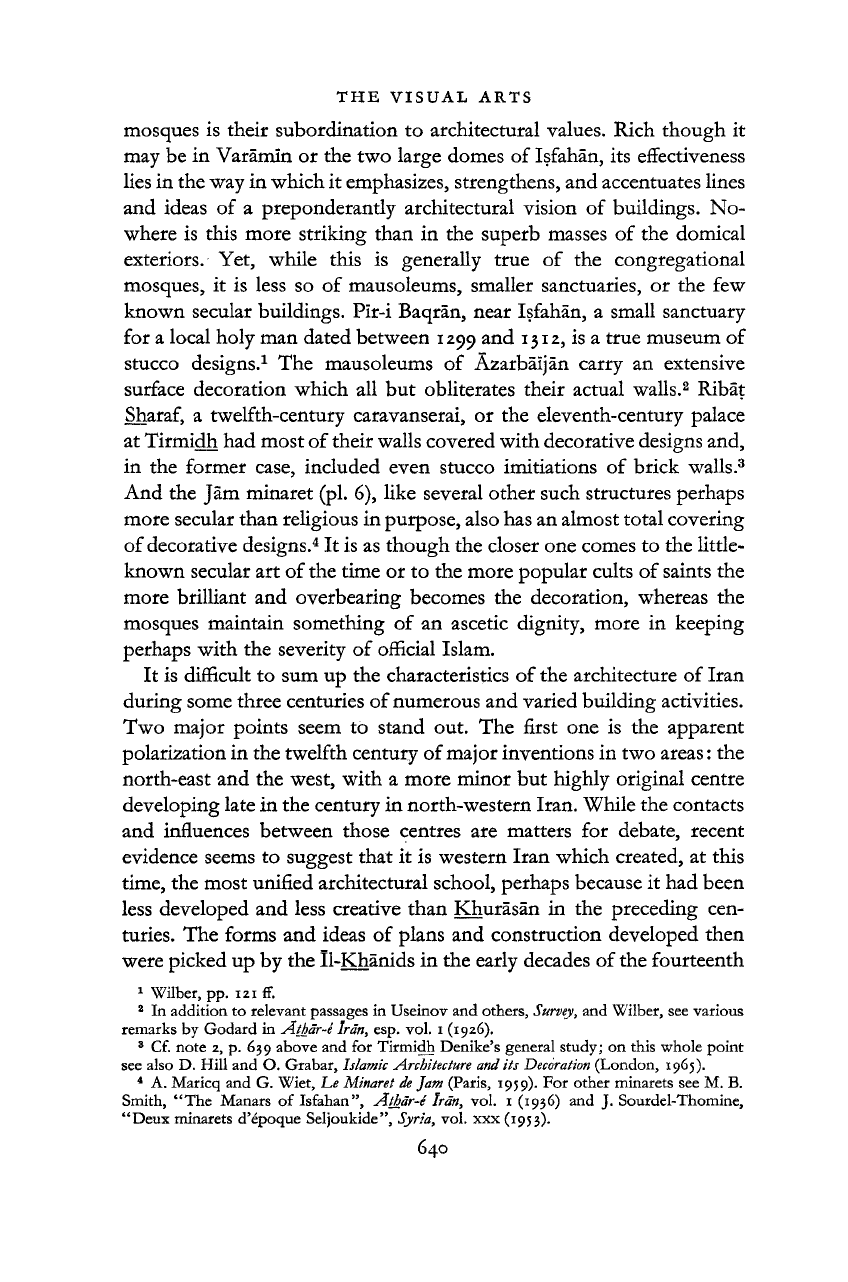
THE
VISUAL ARTS
640
mosques is their subordination to architectural values. Rich though it
may
be in Varamin or the two large domes of Isfahan, its effectiveness
lies
in the way in which it emphasizes, strengthens, and accentuates lines
and ideas of a preponderantly architectural vision of buildings. No-
where is this more striking than in the superb masses of the domical
exteriors.
Yet, while this is generally
true
of the congregational
mosques, it is less so of mausoleums, smaller sanctuaries, or the few
known
secular buildings. Plr-i Baqran, near Isfahan, a small sanctuary
for
a local holy man dated between 1299 and
1312,
is a
true
museum of
stucco
designs.
1
The mausoleums of Azarbaijan carry an extensive
surface decoration which all but obliterates their actual
walls.
2
Ribat
Sharaf, a twelfth-century caravanserai, or the eleventh-century palace
at Tirmi
dh had most of their
walls
covered with decorative designs and,
in the former case, included even stucco imitiations of brick
walls.
3
And
the Jam minaret (pi. 6), like several other such structures perhaps
more secular than religious in purpose, also has an almost total covering
of
decorative designs.
4
It is as though the closer one comes to the little-
known
secular art of the time or to the more popular cults of saints the
more brilliant and overbearing becomes the decoration, whereas the
mosques maintain something of an ascetic dignity, more in keeping
perhaps with the severity of
official
Islam.
It is difficult to sum up the characteristics of the architecture of Iran
during some three centuries of numerous and varied building activities.
Two
major points seem to stand out. The first one is the apparent
polarization in the twelfth century of major inventions in two areas: the
north-east and the west, with a more minor but highly original centre
developing
late in the century in north-western Iran. While the contacts
and influences between those centres are matters for debate, recent
evidence
seems to suggest
that
it is western Iran which created, at this
time, the most unified architectural school, perhaps because it had been
less
developed and less creative than Khurasan in the preceding cen-
turies. The forms and ideas of plans and construction developed then
were
picked up by the Il-Khanids in the early decades of the fourteenth
1
Wilber, pp. 121 ff.
2
In
addition
to
relevant
passages
in
Useinov
and
others,
Survey,
and Wilber, see
various
remarks
by Godard in
Athdr-e
Iran,
esp. vol. i
(1926).
8
Cf.
note
2, p. 639
above
and for
Tirmidh
Denike's
general
study;
on
this
whole
point
see
also
D.
Hill
and O. Grabar,
Islamic
Architecture
and its
Decoration
(London,
1965).
4
A. Maricq and G.
Wiet,
Le
Minaret
de Jam
(Paris,
1959).
For
other
minarets
see M. B.
Smith,
"The Manars of
Isfahan",
Athdr-e
Iran,
vol. 1
(1936)
and J.
Sourdel-Thomine,
"Deux
minarets
d'epoque
Seljoukide",
Syria,
vol. xxx
(1953).
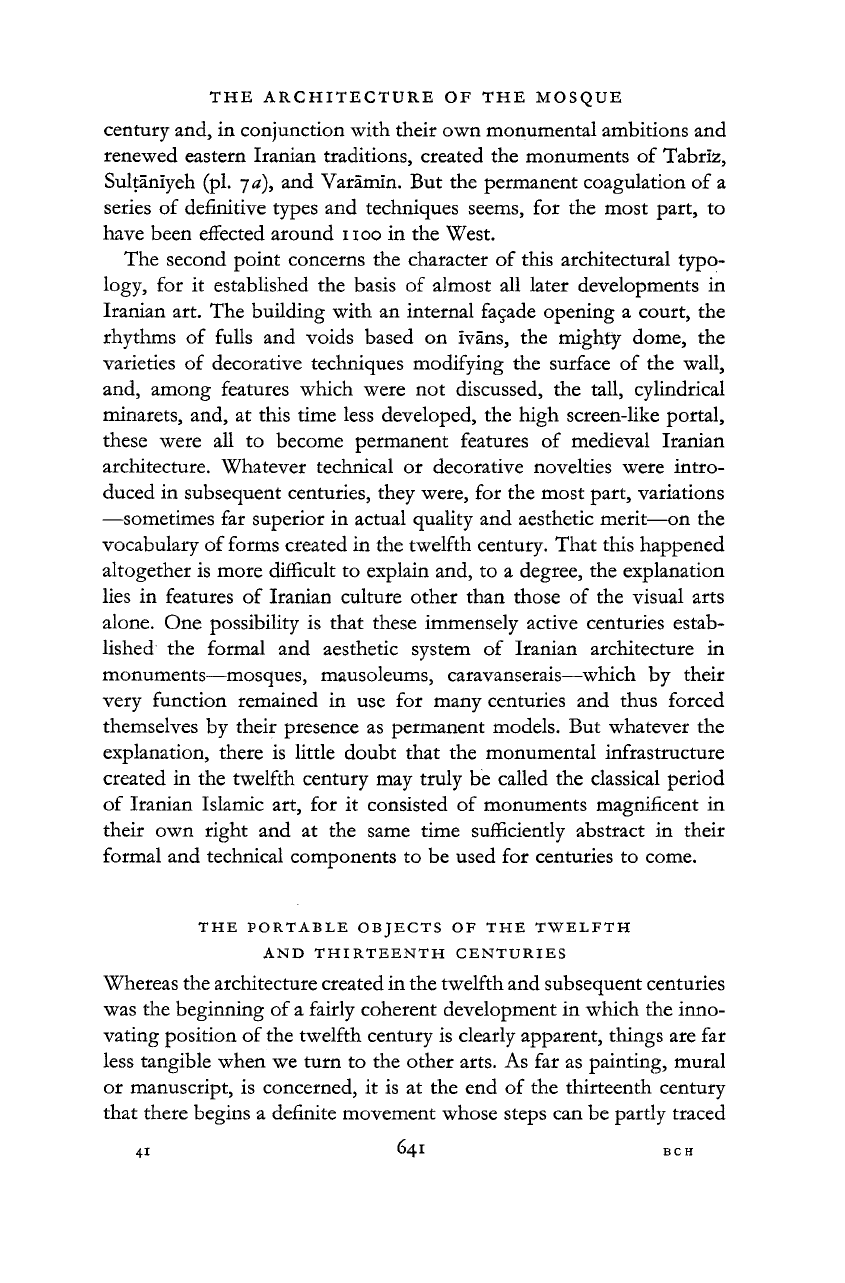
THE ARCHITECTURE OF THE MOSQUE
century and, in conjunction with their own monumental ambitions and
renewed eastern Iranian traditions, created the monuments of Tabriz,
Sultánlyeh (pi. ja), and Varamin. But the permanent coagulation of a
series of definitive types and techniques seems, for the most
part,
to
have been effected around noo in the West.
The
second point concerns the character of this architectural typo-
logy,
for it established the basis of almost all later developments in
Iranian art. The building with an internal facade opening a court, the
rhythms of fulls and voids based on Ivans, the mighty dome, the
varieties of decorative techniques modifying the surface of the
wall,
and, among features which were not discussed, the tall, cylindrical
minarets, and, at this time less developed, the high screen-like portal,
these were all to become permanent features of medieval Iranian
architecture. Whatever technical or decorative novelties were intro-
duced in subsequent centuries, they were, for the most
part,
variations
—sometimes far superior in actual quality and aesthetic merit—on the
vocabulary
of forms created in the twelfth century. That this happened
altogether is more difficult to explain and, to a degree, the explanation
lies
in features of Iranian culture other
than
those of the visual
arts
alone. One possibility is
that
these immensely active centuries estab-
lished the formal and aesthetic system of Iranian architecture in
monuments—mosques, mausoleums, caravanserais—which by their
very
function remained in use for many centuries and
thus
forced
themselves by their presence as permanent models. But whatever the
explanation,
there
is little doubt
that
the monumental infrastructure
created in the twelfth century may truly be called the classical period
of
Iranian Islamic art, for it consisted of monuments magnificent in
their own right and at the same time sufficiently abstract in their
formal and technical components to be used for centuries to come.
THE
PORTABLE
OBJECTS OF THE
TWELFTH
AND THIRTEENTH CENTURIES
Whereas the architecture created in the twelfth and subsequent centuries
was
the beginning of a fairly coherent development in which the inno-
vating position of the twelfth century is clearly apparent, things are far
less
tangible when we
turn
to the other arts. As far as painting, mural
or manuscript, is concerned, it is at the end of the
thirteenth
century
that
there
begins a definite movement whose steps can be partly traced
41 641 BCH
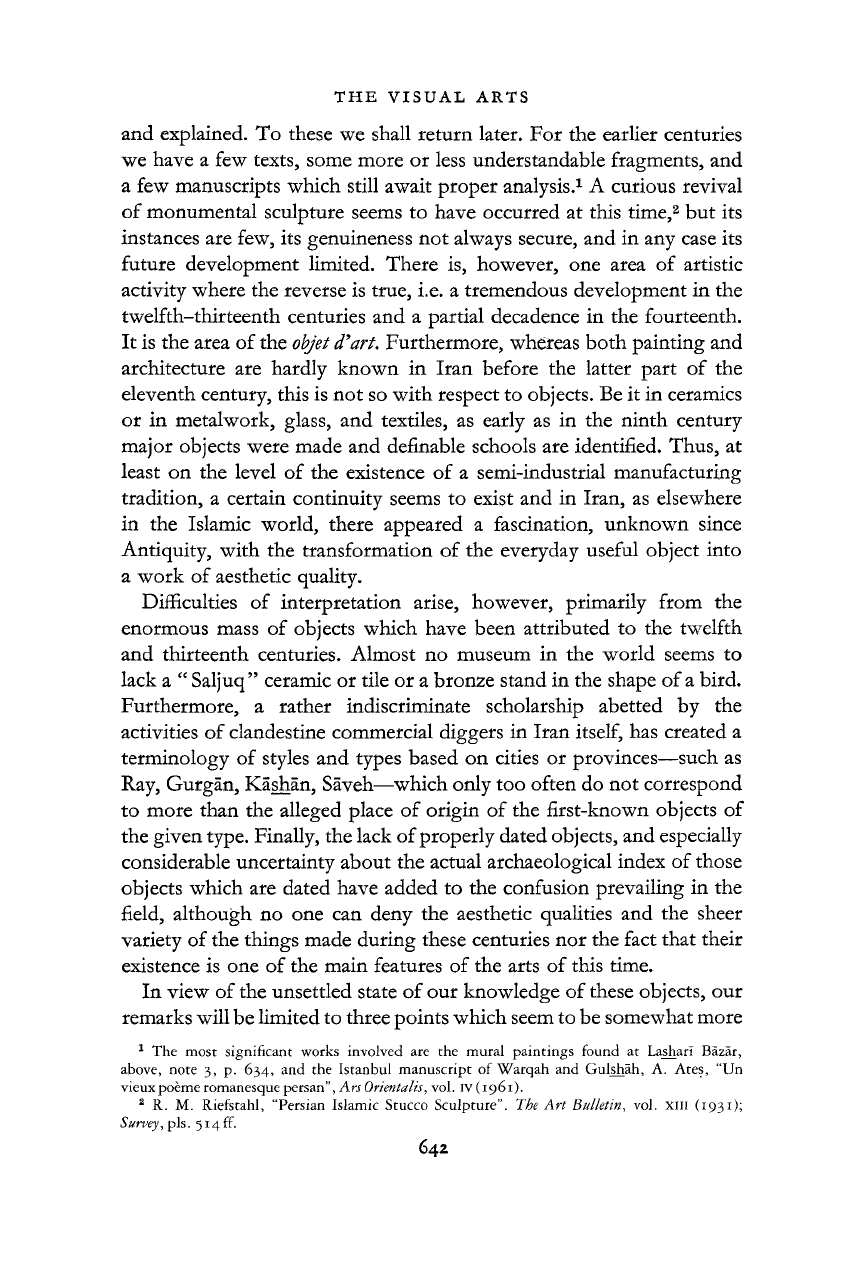
THE VISUAL ARTS
and explained. To these we shall
return
later. For the earlier centuries
we
have a few texts, some more or less understandable fragments, and
a few manuscripts which still await proper analysis.
1
A curious revival
of
monumental sculpture seems to have occurred at this time,
2
but its
instances are few, its genuineness not always secure, and in any case its
future development limited. There is, however, one area of artistic
activity
where the reverse is true, i.e. a tremendous development in the
twelfth-thirteenth centuries and a partial decadence in the fourteenth.
It is the area of the
objet
d'art.
Furthermore, whereas both painting and
architecture are hardly known in
Iran
before the latter
part
of the
eleventh century, this is not so with respect to objects. Be it in ceramics
or in metalwork, glass, and textiles, as early as in the
ninth
century
major objects were made and definable schools are identified. Thus, at
least on the
level
of the existence of a semi-industrial manufacturing
tradition, a certain continuity seems to exist and in
Iran,
as elsewhere
in the Islamic world, there appeared a fascination, unknown since
Antiquity,
with the transformation of the everyday useful object into
a work of aesthetic quality.
Difficulties
of interpretation arise, however, primarily from the
enormous mass of objects which have been attributed to the twelfth
and thirteenth centuries. Almost no museum in the world seems to
lack
a " Saljuq" ceramic or tile or a bronze stand in the shape of a bird.
Furthermore, a
rather
indiscriminate scholarship abetted by the
activities
of clandestine commercial diggers in
Iran
itself, has created a
terminology of styles and types based on cities or provinces—such as
Ray,
Gurgan, Kashan, Saveh—which only too often do not correspond
to more
than
the alleged place of origin of the first-known objects of
the
given
type. Finally, the lack
of
properly dated objects, and especially
considerable uncertainty about the actual archaeological index of those
objects which are dated have added to the confusion prevailing in the
field, although no one can deny the aesthetic qualities and the sheer
variety of the things made during these centuries nor the fact
that
their
existence is one of the main features of the
arts
of this time.
In
view
of the unsettled state of our knowledge of these objects, our
remarks
will
be limited to three points which seem to be somewhat more
1
The
most
significant
works
involved
are the
mural
paintings
found
at
Lasharl
Bazar,
above,
note
3, p. 634, and the
Istanbul
manuscript
of
Warqah
and
Gulshah,
A.
Ates,
"Un
vieux
poeme
romanesque
persan",
Ars
Orientalis,
vol.
IV
(1961).
2
R. M.
Riefstahl,
"Persian Islamic
Stucco
Sculpture".
The Art
Bulletin,
vol. xm
(1931);
Survey,
pis.
5i4ff.
642
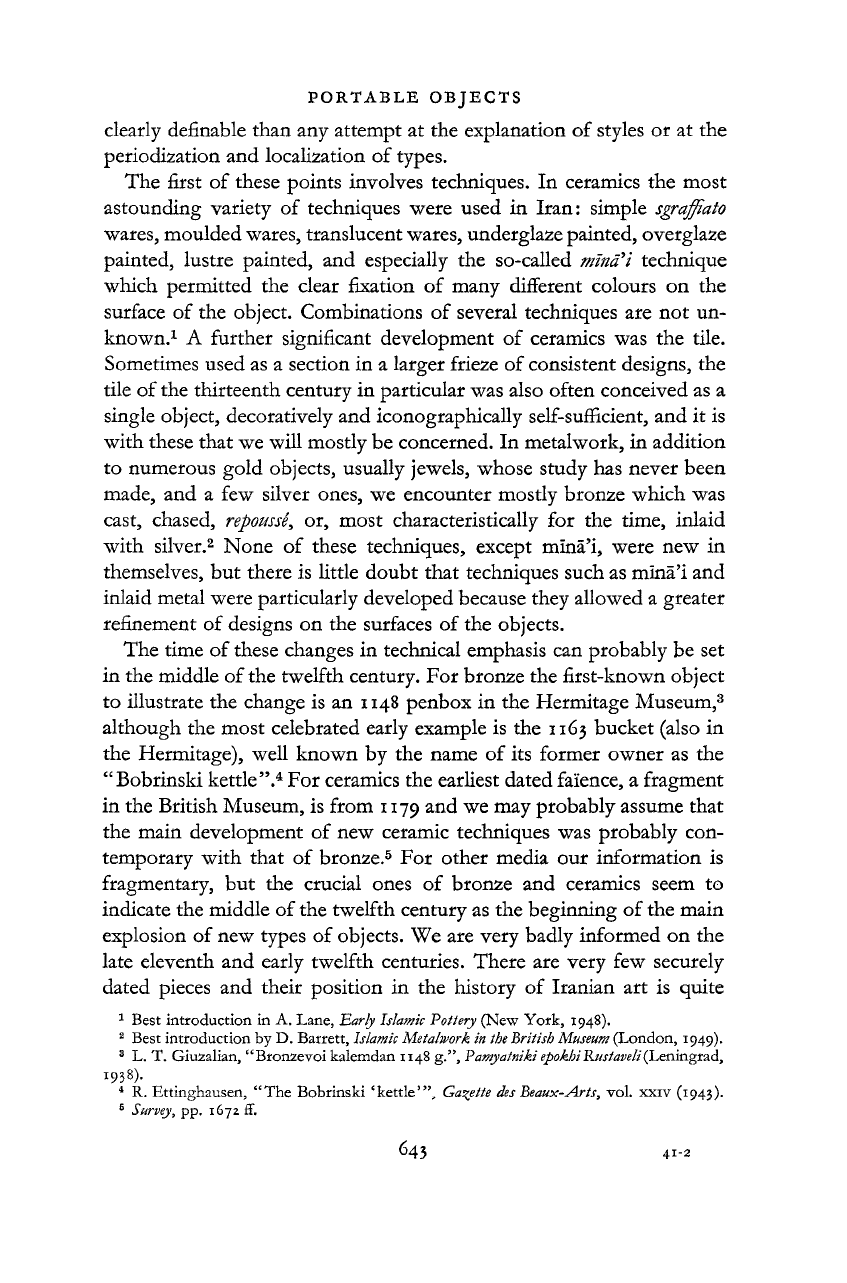
PORTABLE
OBJECTS
643
41-2
clearly
definable
than
any
attempt
at the explanation of styles or at the
periodization and localization of types.
The
first of these points involves techniques. In ceramics the most
astounding variety of techniques were used in
Iran:
simple sgraffiato
wares,
moulded wares, translucent wares, underglaze painted, overglaze
painted, lustre painted, and especially the so-called mincfi technique
which
permitted the clear fixation of many different colours on the
surface of the object. Combinations of several techniques are not un-
known.
1
A further significant development of ceramics was the tile.
Sometimes used as a section in a larger frieze of consistent designs, the
tile of the
thirteenth
century in particular was also often conceived as a
single
object, decoratively and iconographically self-sufficient, and it is
with
these
that
we
will
mostly be concerned. In metalwork, in addition
to numerous gold objects, usually
jewels,
whose study has never been
made, and a few silver ones, we encounter mostly bronze which was
cast, chased,
repousse,
or, most characteristically for the time, inlaid
with
silver.
2
None of these techniques, except mlna'i, were new in
themselves, but
there
is little doubt
that
techniques such as mlna'i and
inlaid metal were particularly developed because they allowed a greater
refinement of designs on the surfaces of the objects.
The
time of these changes in technical emphasis can probably be set
in the middle of the twelfth century. For bronze the first-known object
to illustrate the change is an 1148 penbox in the Hermitage Museum,
3
although the most celebrated early example is the 1163 bucket (also in
the Hermitage),
well
known by the name of its former owner as the
"Bobrinski
kettle".
4
For ceramics the earliest dated faience, a fragment
in the British Museum, is from
1179
and we may probably assume
that
the main development of new ceramic techniques was probably con-
temporary with
that
of bronze.
5
For other media our information is
fragmentary, but the crucial ones of bronze and ceramics seem to
indicate the middle of the twelfth century as the beginning of the main
explosion
of new types of objects. We are very badly informed on the
late eleventh and early twelfth centuries. There are very few securely
dated pieces and their position in the history of
Iranian
art is quite
1
Best
introduction
in A.
Lane,
Early
Islamic
Pottery
(New
York,
1948).
2
Best
introduction
by D.
Barrett,
Islamic
Metalwork
in the
British
Museum
(London,
1949).
3
L. T.
Giuzalian,
"Bronzevoi
kalemdan
1148 g.",
Pamyatniki
epokhi
Rustaveli
(Leningrad,
1938).
4
R.
Ettinghausen,
"The
Bobrinski
*
kettle
"\
Gazette
desBeaux-Arts,
vol.
xxiv
(1943).
5
Survey,
pp. 1672 ff.
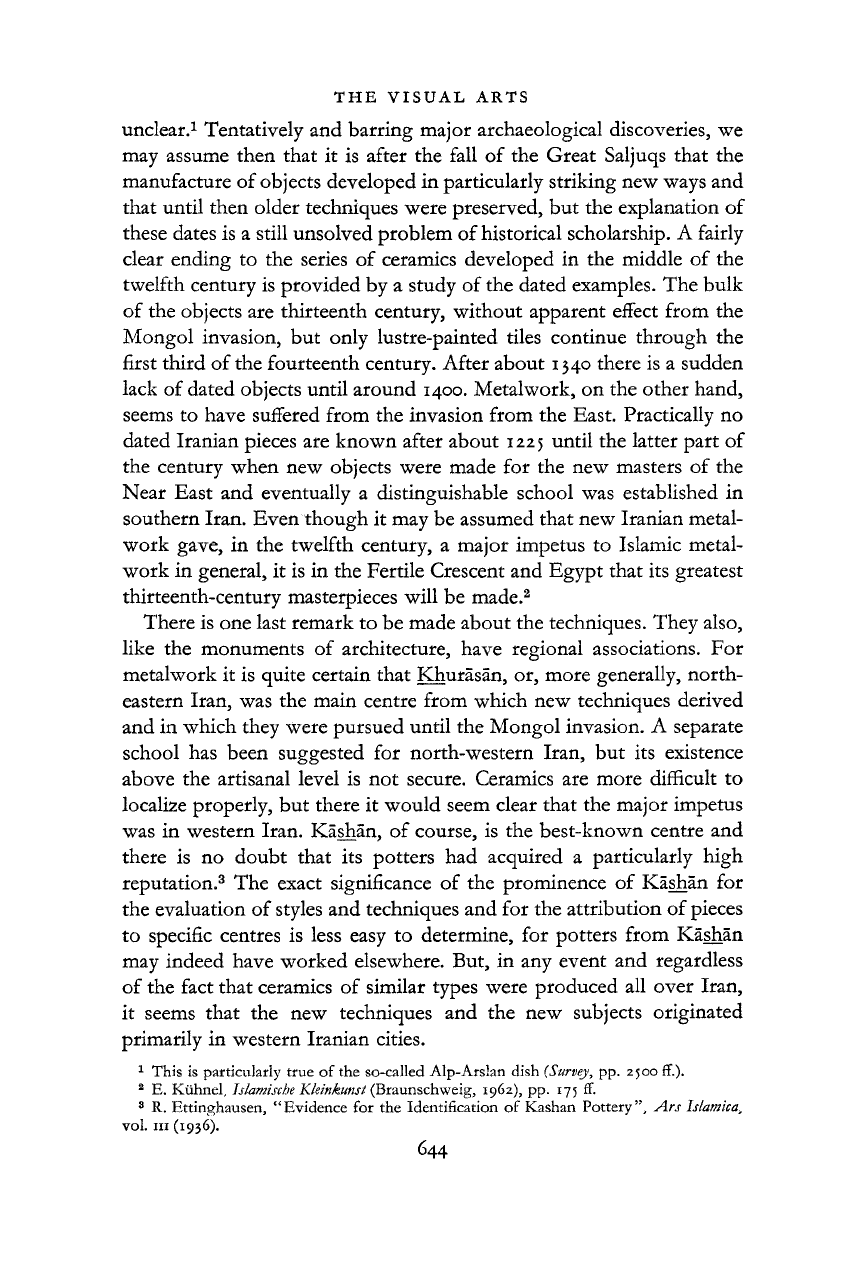
THE
VISUAL ARTS
644
unclear.
1
Tentatively
and
barring major archaeological discoveries,
we
may assume then
that
it is
after
the
fall
of the
Great Saljuqs
that
the
manufacture of objects developed
in
particularly striking new ways and
that
until then older techniques were preserved,
but the
explanation of
these dates
is a
still unsolved problem of historical scholarship.
A
fairly
clear ending
to the
series
of
ceramics developed
in the
middle
of the
twelfth
century is provided by
a
study of the dated examples. The bulk
of
the
objects
are
thirteenth
century, without apparent effect from
the
Mongol
invasion,
but
only lustre-painted tiles continue through
the
first
third
of the fourteenth century. After about 1340
there
is a
sudden
lack
of dated objects until around 1400. Metalwork,
on the
other hand,
seems
to
have suffered from
the
invasion from
the
East. Practically
no
dated Iranian pieces
are
known after about 1225 until
the
latter
part
of
the century when
new
objects were made
for the new
masters
of the
Near East
and
eventually
a
distinguishable school was established
in
southern
Iran.
Even though
it
may be assumed
that
new Iranian metal-
work
gave,
in the
twelfth century,
a
major impetus
to
Islamic metal-
work
in
general,
it is in the
Fertile Crescent and Egypt
that
its
greatest
thirteenth-century masterpieces
will
be
made.
2
There is one last remark
to be
made about the techniques. They also,
like
the
monuments
of
architecture, have regional associations.
For
metalwork
it is
quite certain
that
Khurasan,
or,
more generally,
north-
eastern
Iran,
was
the
main centre from which new techniques derived
and
in
which they were pursued until
the
Mongol invasion.
A
separate
school
has
been suggested
for
north-western
Iran,
but its
existence
above
the
artisanal
level
is not
secure. Ceramics
are
more difficult
to
localize
properly,
but
there
it
would seem clear
that
the
major impetus
was
in
western
Iran.
Kashan,
of
course,
is the
best-known centre
and
there
is no
doubt
that
its
potters
had
acquired
a
particularly high
reputation.
3
The
exact significance
of the
prominence
of
Kashan
for
the evaluation of styles and techniques and
for the
attribution of pieces
to specific centres
is
less easy
to
determine,
for
potters from Kashan
may indeed have worked elsewhere. But,
in any
event
and
regardless
of
the fact
that
ceramics
of
similar types were produced
all
over
Iran,
it seems
that
the new
techniques
and the new
subjects originated
primarily
in
western Iranian cities.
1
This
is
particularly
true
of the
so-called
Alp-Arslan
dish
{Survey,
pp. 2500 ff.).
2
E.
Kiihnef
Jslamische
Kleinkunst
(Braunschweig,
1962),
pp. 175 ff.
8
R.
Ettinghausen,
"Evidence
for the
Identification
of
Kashan
Pottery",
Ars
Islamica,
vol.
in
(1936).
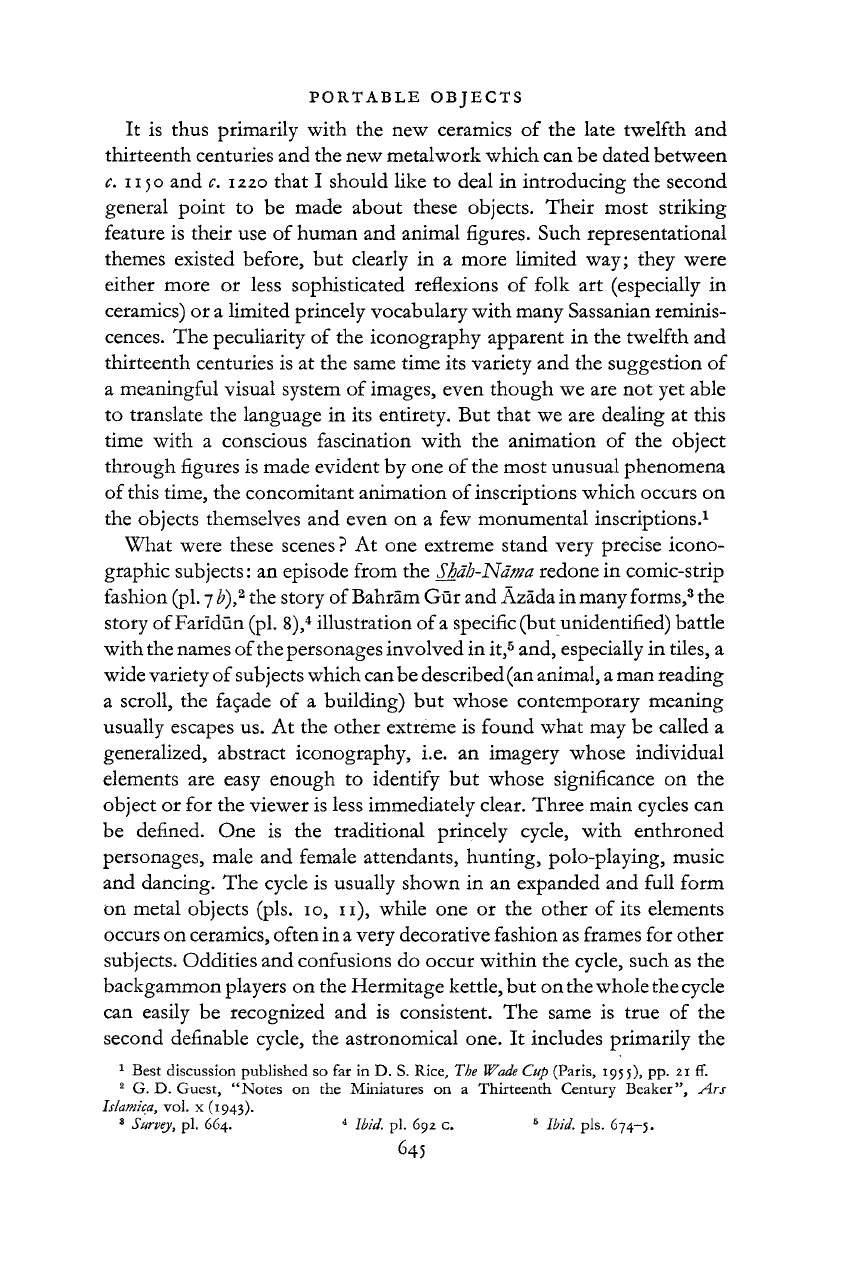
PORTABLE
OBJECTS
It is
thus
primarily with the new ceramics of the late twelfth and
thirteenth
centuries and the new metalwork which can be dated between
c.
1150 and c. 1220
that
I should like to deal in introducing the second
general point to be made about these objects. Their most striking
feature is their use of human and animal figures. Such representational
themes existed before, but clearly in a more limited way; they were
either more or less sophisticated reflexions of
folk
art (especially in
ceramics) or a limited princely vocabulary with many Sassanian reminis-
cences.
The peculiarity of the iconography
apparent
in the twelfth and
thirteenth
centuries is at the same time its variety and the suggestion of
a meaningful visual system of images, even though we are not yet able
to
translate
the language in its entirety. But
that
we are dealing at this
time with a conscious fascination with the animation of the object
through figures is made evident by one of the most unusual phenomena
of
this time, the concomitant animation of inscriptions which occurs on
the objects themselves and even on a few monumental inscriptions.
1
What were these scenes
?
At one extreme
stand
very precise icono-
graphic subjects: an episode from the Shdh-Ndma redone in comic-strip
fashion (pi.
7
b),
2
the story
of
Bahram Gur and
Azada
in many forms,
3
the
story
of
Faridun (pi. 8),
4
illustration
of
a specific (but unidentified) battle
with
the names
of
the personages involved in it,
5
and, especially in tiles, a
wide
variety of subj ects which can be described (an animal, a man reading
a scroll, the facade of a building) but whose contemporary meaning
usually escapes us. At the other extreme is found what may be called a
generalized, abstract iconography, i.e. an imagery whose individual
elements are easy enough to identify but whose significance on the
object
or for the viewer is less immediately clear. Three main
cycles
can
be defined. One is the traditional princely
cycle,
with enthroned
personages, male and female
attendants,
hunting, polo-playing, music
and dancing. The
cycle
is usually shown in an expanded and
full
form
on metal objects (pis. 10, 11), while one or the other of its elements
occurs on ceramics, often in a very decorative fashion as frames for other
subjects. Oddities and confusions do occur within the
cycle,
such as the
backgammon players on the Hermitage kettle, but on the
whole
the
cycle
can easily be recognized and is consistent. The same is
true
of the
second definable
cycle,
the astronomical one. It includes primarily the
1
Best
discussion
published
so far in D. S.
Rice,
The
Wade
Cup
(Paris,
1955),
pp. 21 ff.
2
G. D.
Guest,
"Notes
on the
Miniatures
on a
Thirteenth
Century
Beaker",
Ars
Islamica,
vol. x
(1943).
3
Survey,
pi. 664.
4
Ibid.
pi. 692 c.
5
Ibid.
pis.
674-5.
645
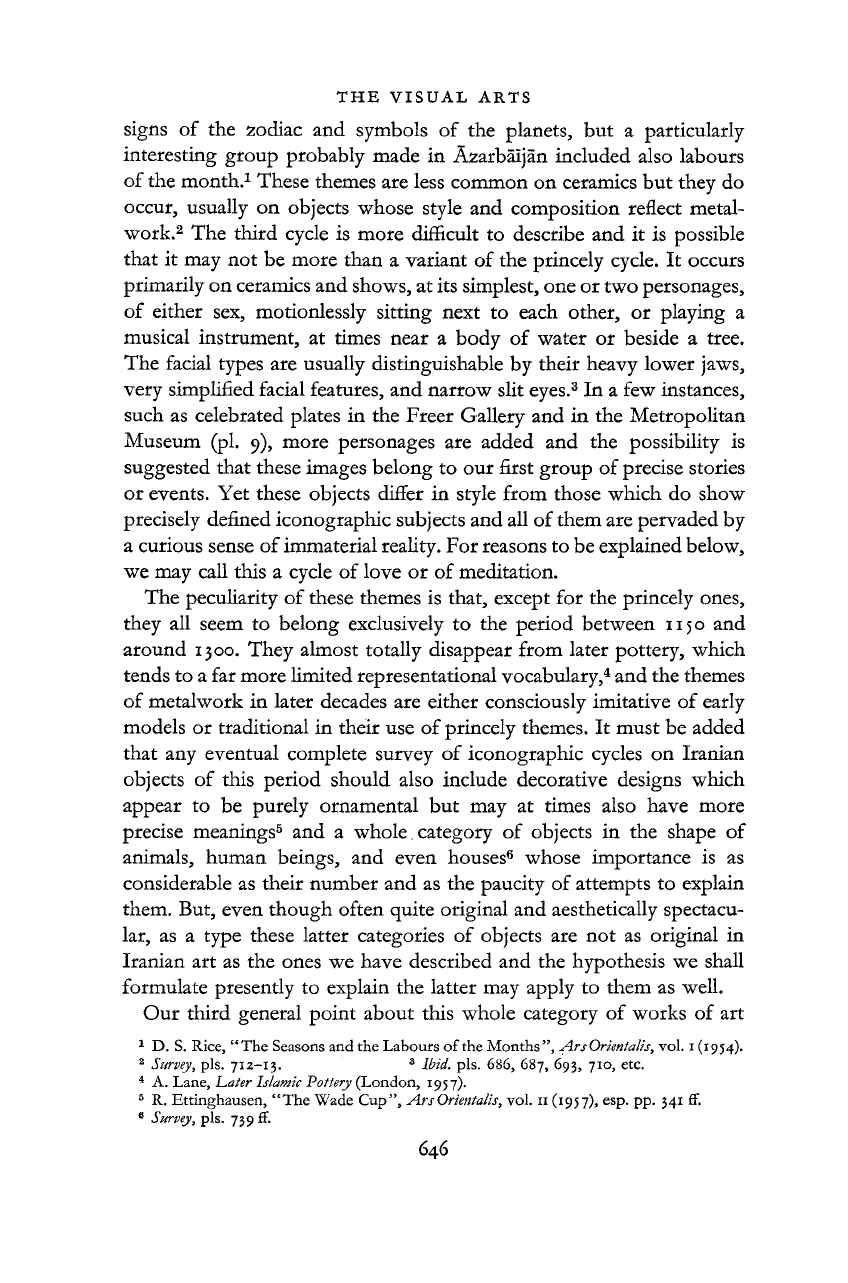
THE
VISUAL ARTS
646
signs
of the
zodiac
and
symbols
of the
planets,
but a
particularly
interesting group probably made
in
Azarbaijan included also labours
of
the month.
1
These themes
are
less common
on
ceramics
but
they
do
occur,
usually
on
objects whose style
and
composition reflect metal-
work.
2
The
third
cycle
is
more difficult
to
describe
and it is
possible
that
it may not be
more
than
a
variant
of the
princely
cycle.
It
occurs
primarily
on
ceramics
and
shows,
at
its simplest, one
or
two personages,
of
either
sex,
motionlessly sitting next
to
each other,
or
playing
a
musical instrument,
at
times near
a
body
of
water
or
beside
a
tree.
The
facial types
are
usually distinguishable
by
their heavy lower
jaws,
very
simplified facial features,
and
narrow slit
eyes.
3
In a
few instances,
such
as
celebrated plates
in the
Freer Gallery
and in the
Metropolitan
Museum
(pi. 9),
more personages
are
added
and the
possibility
is
suggested
that
these images belong
to our
first group
of
precise stories
or events. Yet these objects differ
in
style from those which
do
show
precisely
defined iconographic subjects
and
all of them
are
pervaded
by
a curious sense
of
immaterial reality. For reasons
to be
explained below,
we
may
call
this
a
cycle
of
love
or of
meditation.
The
peculiarity
of
these themes
is
that,
except
for the
princely ones,
they
all
seem
to
belong
exclusively
to the
period between 1150
and
around 1300. They almost totally disappear from later pottery, which
tends
to a far
more limited representational vocabulary,
4
and
the
themes
of
metalwork
in
later decades
are
either consciously imitative
of
early
models
or
traditional
in
their
use of
princely themes.
It
must
be
added
that
any
eventual complete survey
of
iconographic
cycles
on
Iranian
objects
of
this period should also include decorative designs which
appear
to be
purely ornamental
but may at
times also have more
precise meanings
5
and a
whole category
of
objects
in the
shape
of
animals, human beings,
and
even houses
6
whose importance
is as
considerable
as
their number
and as the
paucity
of
attempts
to
explain
them. But, even though often quite original
and
aesthetically spectacu-
lar,
as a
type these latter categories
of
objects
are not as
original
in
Iranian
art as the
ones
we
have described
and the
hypothesis
we
shall
formulate presently
to
explain
the
latter
may
apply
to
them
as
well.
Our
third
general point about this whole category
of
works
of art
1
D. S.
Rice,
"The Seasons and the
Labours
of the
Months",
Ars
Or
tent
alts,
vol. i
(1954).
2
Survey, pis.
712-13.
3
Ibid. pis. 686, 687, 693, 710, etc.
4
A.
Lane,
Later Islamic
Pottery
(London,
1957).
5
R.
Ettinghausen,
"The
Wade
Cup",
ArsOrientalis, vol.
11
(1957),
esp. pp. 341 ff.
6
Survey, pis. 739 ff.
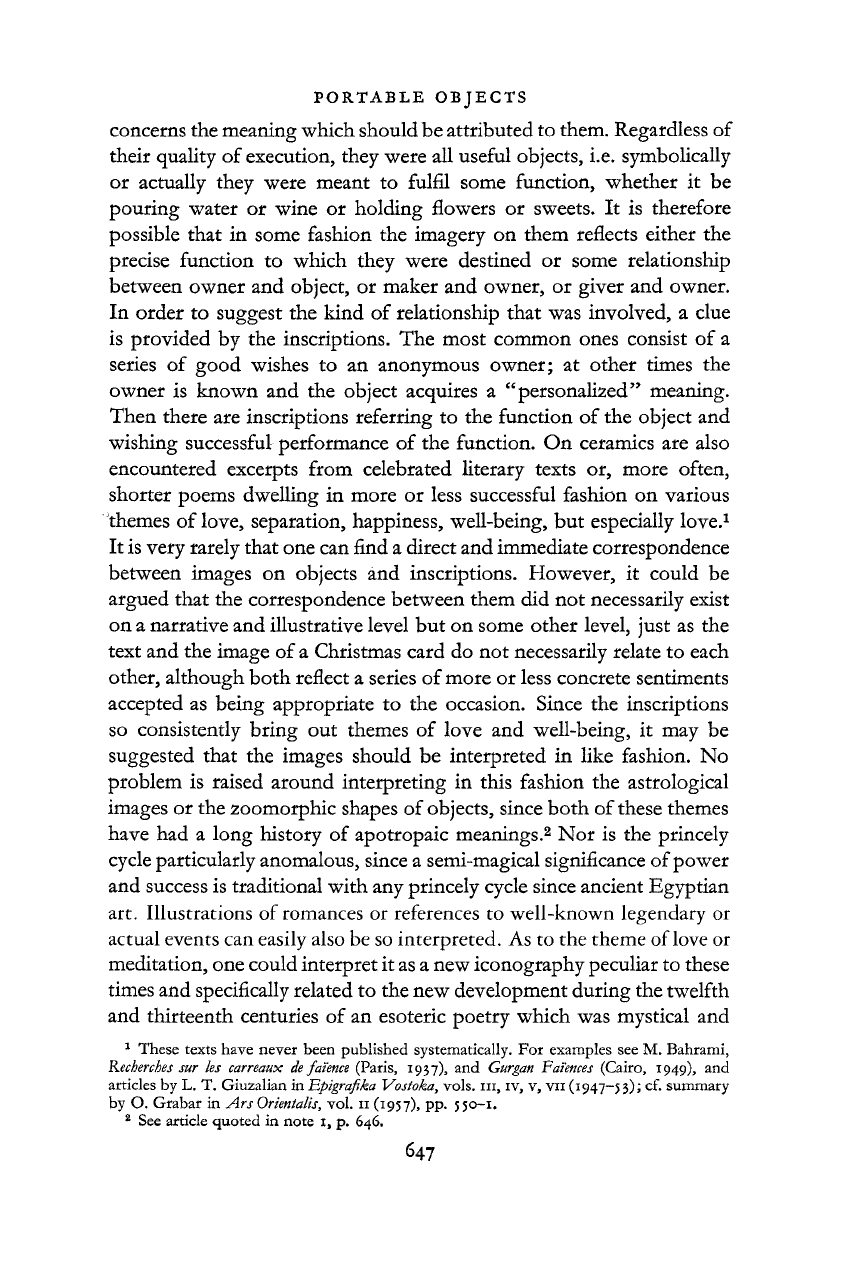
PORTABLE
OBJECTS
647
concerns the meaning which should be
attributed
to them. Regardless of
their quality of execution, they were all useful objects, i.e. symbolically
or actually they were meant to
fulfil
some function, whether it be
pouring water or wine or holding flowers or sweets. It is therefore
possible
that
in some fashion the imagery on them reflects either the
precise function to which they were destined or some relationship
between owner and object, or maker and owner, or giver and owner.
In order to suggest the kind of relationship
that
was involved, a clue
is
provided by the inscriptions. The most common ones consist of a
series of good wishes to an anonymous owner; at other times the
owner is known and the object acquires a "personalized" meaning.
Then
there
are inscriptions referring to the function of the object and
wishing
successful performance of the function. On ceramics are also
encountered excerpts from celebrated literary texts or, more often,
shorter
poems dwelling in more or less successful fashion on various
"themes of
love,
separation, happiness, well-being, but especially
love.
1
It is very rarely
that
one can find a direct and immediate correspondence
between images on objects and inscriptions. However, it could be
argued
that
the correspondence between them did not necessarily exist
on a narrative and illustrative
level
but on some other
level,
just as the
text and the image of a Christmas card do not necessarily relate to each
other, although both reflect a series of more or less concrete sentiments
accepted as being appropriate to the occasion. Since the inscriptions
so consistently bring out themes of love and well-being, it may be
suggested
that
the images should be
interpreted
in like fashion. No
problem is raised around interpreting in this fashion the astrological
images or the zoomorphic shapes of objects, since both of these themes
have had a long history of apotropaic meanings.
2
Nor is the princely
cycle
particularly anomalous, since a semi-magical significance
of
power
and success is traditional with any princely
cycle
since ancient Egyptian
art. Illustrations of romances or references to well-known legendary or
actual events can easily also be so
interpreted.
As to the theme of
love
or
meditation, one could
interpret
it as a new iconography peculiar to these
times and specifically related to the new development during the twelfth
and
thirteenth
centuries of an esoteric poetry which was mystical and
1
These
texts
have
never
been
published
systematically.
For
examples
see M.
Bahrami,
Recherches
sur les
carreaux
de
faience
(Paris,
1937), and
Gurgan
Faiences
(Cairo,
1949),
and
articles
by L. T.
Giuzalian
in
Epigrafika
Vostoka,
vols,
in, iv, v, vn
(1947-53);
cf.
summary
by O. Grabar in Ars
Orientalis,
vol. n
(1957),
pp.
550-1.
2
See
article
quoted
in
note
1, p. 646.
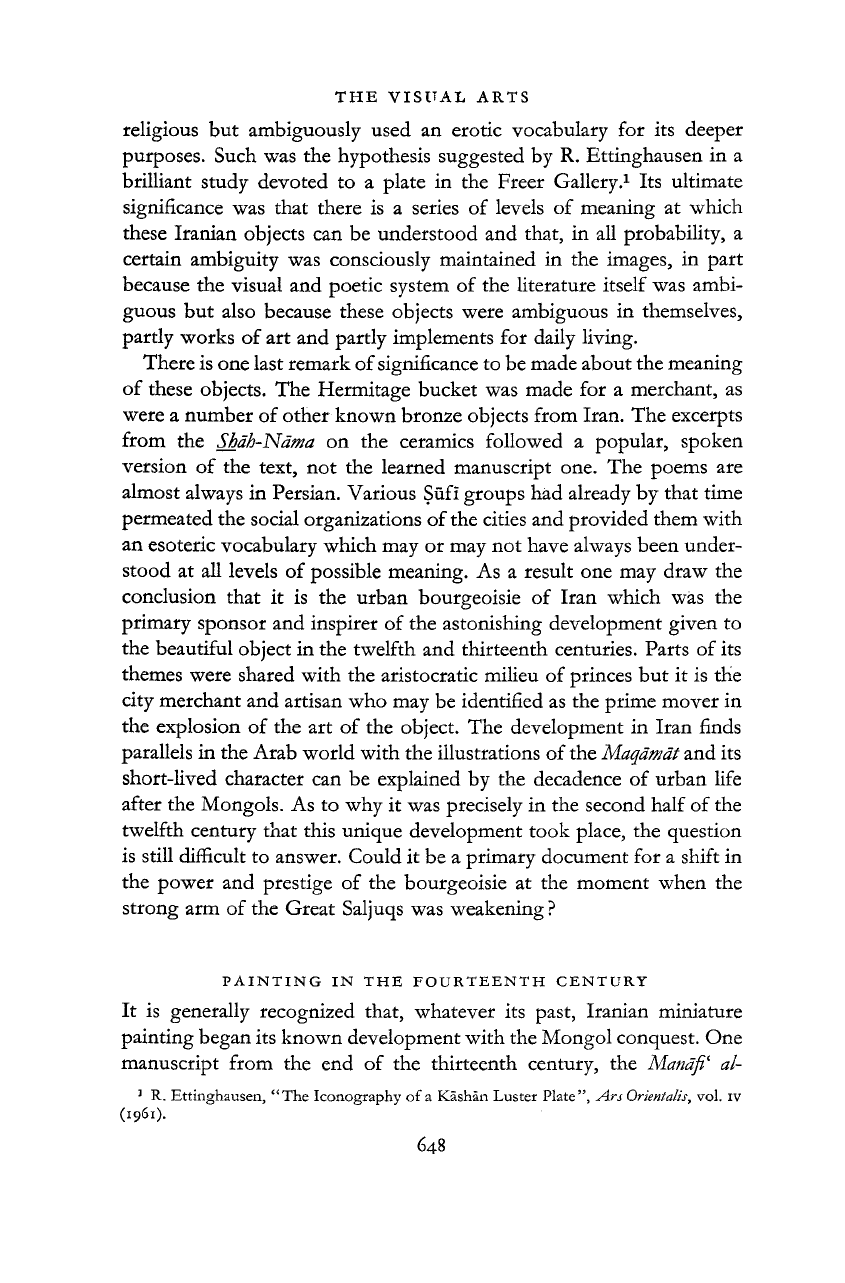
THE
VISUAL
ARTS
religious
but
ambiguously used
an
erotic vocabulary
for its
deeper
purposes. Such was
the
hypothesis suggested
by R.
Ettinghausen
in a
brilliant study devoted
to a
plate
in the
Freer Gallery.
1
Its
ultimate
significance
was
that
there
is a
series
of
levels
of
meaning
at
which
these Iranian objects
can be
understood
and
that,
in all
probability,
a
certain ambiguity
was
consciously maintained
in the
images,
in
part
because
the
visual
and
poetic system
of the
literature itself was ambi-
guous
but
also because these objects were ambiguous
in
themselves,
partly works
of art and
partly implements
for
daily
living.
There is one last remark of significance
to
be made about the meaning
of
these objects.
The
Hermitage bucket was made
for a
merchant,
as
were
a
number of other known bronze objects from
Iran.
The excerpts
from
the
Shdh-Ndma
on the
ceramics followed
a
popular, spoken
version
of the
text,
not the
learned manuscript
one. The
poems
are
almost always
in
Persian. Various Sufi groups
had
already by
that
time
permeated the social organizations of the cities and provided them with
an esoteric vocabulary which may
or
may
not
have always been under-
stood
at all
levels
of
possible meaning. As
a
result
one
may draw
the
conclusion
that
it is the
urban bourgeoisie
of
Iran
which
was the
primary sponsor
and
inspirer
of
the astonishing development given
to
the beautiful object
in the
twelfth
and
thirteenth centuries. Parts
of
its
themes were shared with
the
aristocratic milieu
of
princes
but it is the
city
merchant
and
artisan who may
be
identified
as the
prime mover
in
the explosion
of the art of the
object.
The
development
in
Iran
finds
parallels
in
the Arab world with the illustrations of the Maqdmdt and
its
short-lived character
can be
explained
by the
decadence
of
urban
life
after
the
Mongols. As
to
why
it
was precisely
in the
second half
of
the
twelfth
century
that
this unique development took place,
the
question
is
still difficult
to
answer. Could
it be a
primary document
for a
shift
in
the power
and
prestige
of the
bourgeoisie
at the
moment when
the
strong
arm of
the Great Saljuqs was weakening ?
PAINTING
IN THE
FOURTEENTH CENTURY
It
is
generally recognized
that,
whatever
its
past, Iranian miniature
painting began its known development with the Mongol conquest. One
manuscript from
the end of the
thirteenth century,
the
Mandfi'
al-
3
R. Ettinghausen, "The Iconography of a Kashan Luster Plate", Ars
Orienfalis,
vol. iv
(i960.
648
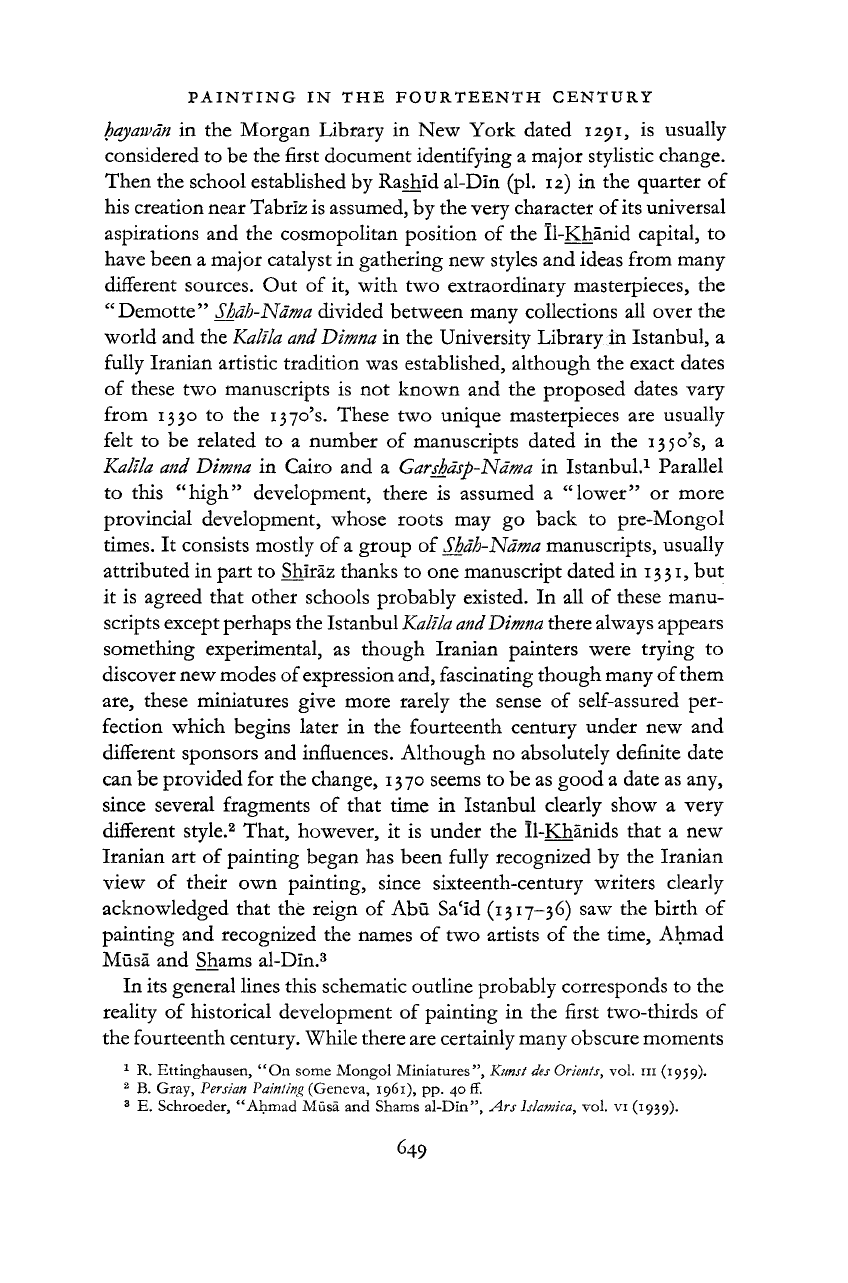
PAINTING IN THE FOURTEENTH CENTURY
649
hayawdn
in the Morgan Library in New
York
dated 1291, is usually
considered to be the first document identifying a major stylistic change.
Then the school established by Rashid al-Din (pi. 12) in the quarter of
his creation near Tabriz is assumed, by the very character of its universal
aspirations and the cosmopolitan position of the Il-Khanid capital, to
have been a major catalyst in gathering new styles and ideas from many
different sources. Out of it, with two extraordinary masterpieces, the
"Demotte" Shdh-Ndma divided between many collections all over the
world
and the Kallla and Dimna in the University Library jn Istanbul, a
fully
Iranian artistic tradition was established, although the exact dates
of
these two manuscripts is not known and the proposed dates vary
from 1330 to the
1370's.
These two unique masterpieces are usually
felt
to be related to a number of manuscripts dated in the 1350's, a
Kallla
and Dimna in Cairo and a Garshasp- Nam
a
in Istanbul.
1
Parallel
to this "high" development, there is assumed a "lower" or more
provincial
development, whose roots may go back to pre-Mongol
times. It consists mostly of a group of Shdh-Ndma manuscripts, usually
attributed in
part
to Shlràz thanks to one manuscript dated in
13
31,
but
it is agreed
that
other schools probably existed. In all of these manu-
scripts except perhaps the Istanbul Kallla and Dimna there
always
appears
something experimental, as though Iranian painters were trying to
discover
new modes
of
expression and, fascinating though many
of
them
are, these miniatures
give
more rarely the sense of self-assured per-
fection
which begins later in the fourteenth century under new and
different sponsors and influences. Although no absolutely definite date
can be provided for the change, 1370 seems to be as good a date as any,
since several fragments of
that
time in Istanbul clearly show a very
different style.
2
That, however, it is under the Il-Khànids
that
a new
Iranian art of painting began has been fully recognized by the Iranian
view
of their own painting, since sixteenth-century writers clearly
acknowledged
that
thè reign of Abu Sa'Id
(1317-36)
saw the birth of
painting and recognized the names of two artists of the time, Ahmad
Musa
and Shams al-Din.
3
In its general lines this schematic outline probably corresponds to the
reality of historical development of painting in the first two-thirds of
the fourteenth century. While there are certainly many obscure moments
1
R.
Ettinghausen,
"On
some
Mongol
Miniatures",
Kunst
des
Orients,
vol. in
(1959).
2
B. Gray,
Persian
Painting
(Geneva,
1961), pp. 40 ff.
3
E.
Schroeder,
"Ahmad Musa
and
Shams
al-Din",
Ars
Islamica,
vol. vi
(1939).
